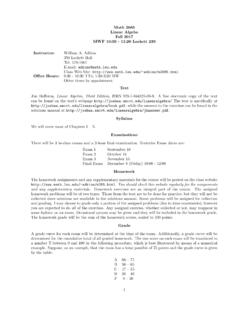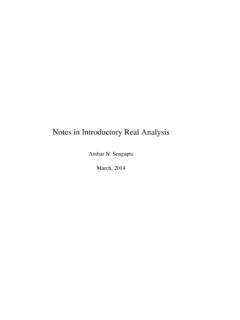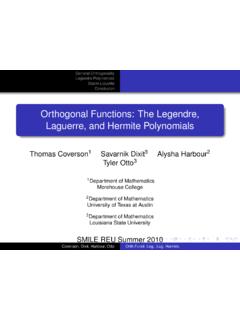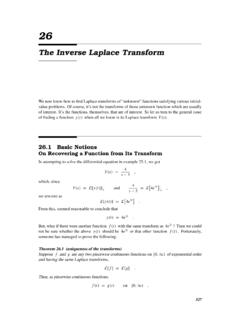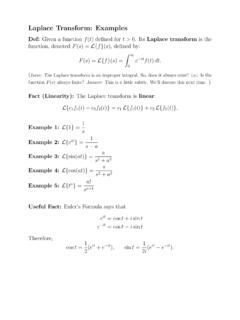Transcription of EXPLORATION OF SPECIAL CASES OF LAPLACE …
1 EXPLORATION OF SPECIAL CASES OF LAPLACETRANSFORMSSARAMARGARET MLADENKA,TRI NGO,KIMBERLY WARD,STEPHEN of all this paper discusses details of the gammafunction and explores some of its properties. Next, some of theproperties of Laguerre functions are shown as well as how thesefunctions relate to LAPLACE Transforms. In further study, differen-tial equations and properties of LAPLACE transform will be used tocalculate the LAPLACE transform of functions. Finally, many pointsof linear recursion relations will be explored and the LAPLACE trans - form will be used to solve Gamma polynomial p(x) in powers of x is a finite sum ofterms like( )p(x) =n k=0akxkwhere k is a non-negative integer. The set of orthogonal polynomi-als contains polynomials that vanish when the product of any twodifferent ones, multiplied by a functionw(x), called a weight func-tion, are integrated over a certain interval.
2 This makes it possibleto expand an arbitrary function f(x) as a sum of the polynomials,each multiplied by a coefficient c(k), which is uniquely determinedby integration. The Laguerre polynomials are orthogonal on theinterval from 0 to with respect to the weight function w(x) =e x. They also have many interesting properties and identitiessome of which involve differential operators, recursion and integra-tion. The LAPLACE transform is used to prove them s equation( )ty + (1 t)y +ny= 0,1where n is a nonnegative intger, is known as Laguerre s equation oforder n. This differential equation possesses the polynomial solution( )ln(t) =n k=0n!( 1)ktk(k!)2(n k)!The functionln(t) is known as the Laguerre polynomial of degree n6= m,( ) 0e tln(t)lm(t)dt= of Laguerre Heading 1 Maple TextOutput Maple Dash Item Maple Bullet Item Maple Normal MapleHeading 4 Maple Heading 3 Maple Heading 2 Maple Warning MapleTitle Maple Error Maple Hyperlink Maple 2D Math Maple Maple InputMaple 2D Output Maple 2D Input active2drestart; 1active2dLaguerreL(3, t); 1inert2dLaguerreL(3, t)LaguerreL(3,t)active2dl0 := simplify( inert2dl0 := 1-3*x+(3/2)*x2 (1/6) x3l3:= 1 3t+ 3/2t2 1/6t3active2dplot(l0, x = -5.))
3 10); first few Laguerre polynomials are:l0= 1l1= t+ 1l2=12(t2 4t+ 2)l3=16( t3+ 9t2 18t+ 6) =tD2+DAn=tD2+ (1 t)D+nwith the Laguerre polynomial denoted asln. ThenE ln= nln =An+tD n3 Multiply both sides of the equation ln= [An+tD n]ln= nln 1tl n nln= nln 1 tl n+nln=nln 1 Then, we proceed in transform space. So, apply the LAPLACE transformto both sides of the equation withLn=L{ln}=(s 1)nsn+1and { tl n+nln}= [ (sLn(s) ln(0))] +nLn= [ (Ln+sL n)] +nLn=Ln+sL n+nLn=sL n+ (1 +n)Ln=s[(s 1)nsn+1] + (1 +n)(s 1)nsn+1=s[n(s 1)n 1(s 1)n+1 (n+ 1)sn(s 1)ns2n+2]+(1 +n)(s 1)nsn+1=n(s 1)n 1s2 (n+ 1)(s 1)nssn+2+ (1 +n)(s 1)nssn+2=n(s 1)n 1sn 1=nL{ln 1}(s) Theorem 2tD2+ (2 2t)D 1An=tD2+ (1 t)D+nAnln= 0with the Laguerre polynomial denoted asln. ThenEOln= (2n+ 1) 22An= 2tD2+ 2(1 t)D+ 2n2 Anln= [2tD2+ 2(1 t)D+ 2n]ln0 = [2tD2+ 2(1 t)D+ 2n]ln4 Add (2n+ 1)lnto both sides of the equation and simplify (2n+ 1)ln= [2tD2+ 2(1 t)D+ 2n]ln (2n+ 1)ln (2n+ 1)ln= [2tD2+ 2(1 t)D 1]ln (2n+ 1)ln=EOln Theorem +=tD2+ (1 2t)D+ (t 1)An=tD2+ (1 t)D+nAnln= 0 ThenE+ln= (n+ 1)ln+ +=An tD (1 t n)Multiply bylnE+ln= [An tD (1 t n)]ln= (n+ 1)ln+1 tl n (1 t+n)ln= (n+ 1)ln+1tl n+ (1 t+n)ln= (n+ 1)ln+15 Then, we proceed in transform space.
4 So, apply the LAPLACE transformto both sides of the equation. LetLn=L{ln}=(s 1)nsn+1L{tl n+ (1 t+n)ln}= (sLn(s) ln(0)) + (1 +n)Ln(s) +L n(s)= (Ln+sL n) + (1 +n)Ln+L n= (s 1)L n+nLn= (s 1)[(s 1)nsn+1] +n[(s 1)nsn+1]= (s 1)[n(s 1)n 1(s 1)n+1 (n+ 1)sn(s 1)ns2n+2]+n[(s 1)nsn+1]= (s 1)[n(s 1)n 1(s 1)s (n+ 1)(s 1)nsn+2]+n[(s 1)nsn+1]= (s 1)[(s 1)n 1[ns (n+ 1)(s 1)]sn+2] +n(s 1)nsn+1= (s 1)n(n s+ 1)sn+2+n(s 1)nsn+1=(s 1)n( n+s 1 +ns)sn+2=(s 1)n(n+ 1)(s 1)sn+2= (n+ 1)(s 1)n+1sn+2= (n+ 1)L{ln+1}(s) Lie Bracket is defined as[A,B] =AB BA. LetEO= 2tD2+ (2 2t)D 1E+=tD2+ (1 2t)D+ (t 1)Then[E0,E+] = [E0,E+] = 2E0=E0E+ E+E0( )E0E+= 2tE ++ (2 2t)E + E+( )E+E0=tE 0+ (1 2t)E 0+ (t 1)E0( )and 2E+= 2tD2+ ( 2 + 4t)D+ ( 2t+ 2)( )We must find the first and second derivatives ofE0E0= 2tD2+ (2 2t)D 1E 0= 2tD3+ (4 2t)D2 3DE 0= 2tD4+ (6 2t)D3 5D2 Now, we must find the first and second derivatives ofE+E+=tD2+ (1 2t)D+t 1 Note that in the operator,t 1 means (t 1)f(t), so we haveddt[t 1] =ddt[(t 1)f(t)] = (t 1)f (t) +f(t) = (t 1)D+ 1 Using that we getE +=tD3+ (2 2t)D2+ (t 3)D+ 1andE +=tD4+ (3 2t)D3+ (t 5)D2+ 2 DNow, we substitute in the derivatives into (6) and (7)E0E+= 2tE ++ (2 2t)E + E+= 2t[tD4+ (3 2t)D3+ (t 5)D2+ 2D] + (2 2t)[tD3+ (2 2t)D2+ (t 3)D+ 1] [tD2+ (1 2t)]
5 D+t 1]= 2t2D4+D3[6t 4t2+ 2t 2t2] +D2[2t2 10t+ 4 8t+ 4t2 t]+D[4t+ (2 2t)(t 3) + 2t 1] + 2 2t t+ 1= 2t2D4+ ( 6t2+ 8t)D3+ (6t2 19t+ 4)D2+ ( 2t2+ 14t 7)D 3t+ 37E+E0=tE 0+ (1 2t)E 0+ (t 1)E0=t[2tD4+ (6 2t)D3 5D2] + (1 2t)[2tD3+ (4 2t)D2 3D]+(t 1)[2tD2+ (2 2t)D 1]= 2t2D4+D3[6t 2t2+ 2t 4t2] +D2[ 5t+ 4 10t+ 4t2+ 2t2 2t]+D[6t 3 2t2+ 4t 2] t+ 1= 2t2D4+ ( 6t2+ 8t)D3+ (6t2 17t+ 4)D2+ ( 2t2+ 10t 5)D t+ 1 Now, we plug everything into (5)E0E+ E+E0= (2t2 2t2)D4+ [( 6t2+ 8t) ( 6t2+ 8t)]D3+ [(6t2 19t+ 4) (6t2 17t+ 4)]D2+ [( 2t2+ 14t 7) ( 2t2+ 10t 5)]D 3t+ 3 ( t+ 1)= 2tD2+ (4t 2)D 2t+ 2 Then using (5) and (8) we conclude that[E0,E+] = 2E+ of the Laguerre {ln(at)}=n k=0(nk)( 1)kakL{tkk!}ThenL{ln(at)}=(s a)nsn+1when a < take the LAPLACE transform of the summation and simplifyL{ln(at)}=n k=0(nk)( 1)kakL{tkk!}
6 }=n k=0(nk)( 1)kak1sk+1=1sn+1n k=0(nk)( a)ksn kfollowing from the binomial theorem,(s+a)n=n k=0(nk)aksn k8we get(s a)n=n k=0(nk)( a)ksn kSo,L{ln(at)}=1sn+1n k=0(nk)( a)ksn k=(s a)nsn+1 Theorem k=0(nk)aklk(t)(1 a)n k=ln(at) the LAPLACE {n k=0(nk)aklk(t)(1 a)n k}=L{ln(at)}L{n k=0(nk)aklk(t)(1 a)n k}=n k=0(nk)ak(s 1)ksk+1(1 a)n k=1sn k=0(nk)ak(s 1)ksk(1 a)n k=1sn k=0(nk)(a as)k(1 a)n kusing the binomial theorem, we get1sn k=0(nk)(a as)k(1 a)n k=1s(1 a+a as)n=1s(1 as)n=1s(s as)n=(s a)nsn+1L{n k=0(nk)aklk(t)(1 a)n k}=L{ln(at)}9By taking the inverse LAPLACE transform , we can conclude thatn k=0(nk)aklk(t)(1 a)n k=ln(at) Theorem t0ln(x)dx=ln(t) ln+1(t) know thatln 1(t) = t0ln(x)dxBy the convolution theorem, we also know thatL{ln 1}(s) =L{ln}L{1}So we take the LAPLACE transform oflnand 1L{ln}L{1}=1s(s 1)nsn+1L{ln}L{1}= (1 s 1s)(s 1)nsn+1 SinceL{ln 1}(s) =L{ln}L{1}we haveL{ln 1}(s) =(s 1)nsn+1 (s 1)n+1sn+2L{ln 1}(s) =L{ln}(s) L{ln+1}(s)Apply the inverse LAPLACE transformln 1 =ln(t) ln+1(t)By convolution, we can conlude that t0ln(x)dx=ln(t) ln+1(t) Theorem t0ln(x)lm(t x)dx=lm+n(t) lm+n+1(t) know thatln lm(t) = t0ln(x)lm(t x)dxBy the convolution theorem, we also know thatL{ln lm}(s) =L{ln}L{lm}So we take the LAPLACE transform oflnandlmL{ln}L{lm}=(s 1)nsn+1(s 1)msm+1L{ln}L{lm}= (1 s 1s)(s 1)n+msn+m+110 SinceL{ln lm}(s) =L{ln}L{lm}we haveL{ln lm}(s) =(s 1)n+msn+m+1 (s 1)m+n+1sm+n+2L{ln lm}(s) =L{ln+m}(s) L{ln+m+1}(s)Apply the inverse LAPLACE transformln lm=lm+n(t) lm+n+1(t)
7 By convolution, we can conlude that t0ln(x)lm(t x)dx=lm+n(t) lm+n+1(t) Theorem +1(t) =1n+ 1[(2n+ 1 t)ln(t) nln 1(t)] the LAPLACE transform to both sides of the equation andsimplify. LetLn=L{ln}=(s 1)nsn+1L{ln+1(t)}=L{1n+ 1[(2n+ 1 t)ln(t) nln 1(t)]}=1n+ 1[(2n+ 1)Ln+L n nLn 1]=1n+ 1[(2n+ 1)[(s 1)nsn+1] + [(s 1)nsn+1] n[(s 1)n 1sn]]=1n+ 1[(2n+ 1)(s 1)nsn+1+n(s 1)n 1(s)n+1 (n+ 1)sn(s 1)ns2n+2 n(s 1)n 1sn]=1n+ 1[(2n+ 1)(s 1)nsn+1+n(s 1)n 1s (n+ 1)(s 1)nsn+2 n(s 1)n 1sn]=1n+ 1[(2n+ 1)(s 1)n 1(s(s 1))sn+2+n(s 1)n 1s (n+ 1)(s 1)nsn+2 ns2(s 1)n 1sn+2]=1n+ 1((s 1)n 1sn+2)[(2n+ 1)(s(s 1)) + (n s+ 1) ns2]=1n+ 1((s 1)n 1sn+2)[(n+ 1)(s 1)2]=(s 1)n 1sn+2(s 1)2=(s 1)n+1sn+2=L{ln+1(t)}By applying the inverse LAPLACE transform we can conclude thatln+1(t) =1n+ 1[(2n+ 1 t)ln(t) nln 1(t)] Differential Equations to Compute LAPLACE transform of a function, F(t), isf(s) = 0e atF(t) Table 1 are based on this (s) =L{F(t)}, then(1)sf(s) F(0) =L{F (t)}(2)f (s)
8 =L{ tF(t)}Therefore, the following table is (s)F(t)xXsx X(0)X s2x sX(0) X (0)X x tX sx xtX s2x 2sx+X(0)tX x t2 Xsx + 2x t2X s2x + 4sx + 2xt2X Table LAPLACE TransformsThere are several other theorems that will also be useful to solveLaplace Transforms using differential (t) At ( > 1)ast 0,x(s) A ( + 1)s +1as s Theorem (t) Bt ( > 1)ast ,x(s) B ( + 1)s +1as s first method used to compute LAPLACE trans -forms uses Table??above to find the proper differential LAPLACE transform of the zeroth-order Bessel Func-tion is the following:L{J0(t)}=1 s2+ 1and the LAPLACE transform of the first-order Bessel Function is:L{J1(t)}= s2+ 1 s s2+ 113 Proof of Theorem??.The LAPLACE transform of the zeroth-order BesselFunction, denotedJ0(t), is the solution of the differential equationtX +X +tX= 0.
9 By applying Table??to get the LAPLACE trans - form , one can derive the equations2x 2sx+X(0)+sx X(0) x = this into the standard form of the differential equation gives:x +ss2+ 1x= order to solve this differential equation, one has to find the Integrat-ing factor, which is defined byI(t) =e ss2+ 1dsBy solving the integral and simplifying, the integrating factor is shownto be s2+ 1. Multiplying the differential equation by the integratingfactor gives s2+ 1x + s2+ 1ss2+1x= 0, and integrating both sidesof the equation gives s2+ 1x=c, where c is the integration this we can see thatx(s) =c s2+1. According to Theorem??,c= 1 becausex(s) 1/sass . Therefore,L{J0(t)}=1 s2+ order to deriveL{J1(t)}, the equalityJ 0(t) = J1(t) and Theorem??are used by placingF(t) =J0(t) andF (t) = J1(t).
10 ThenL{J1(t)}= s2+ 1 s s2+ 1and the Theorem is proved. Theorem LAPLACE transform of the functionX(t) = sina tcan be stated as:L{sina t}=a 2s3/2e a24sProof of Theorem??.In order to prove this theorem, the equationX(t) = sin(a t) must be used. To find a differential equation tosolve forx(s) one must take the derivative twice and set the equationequal to zero to get the constants. Putting these 3 equations togetherto equal zero results in the differential equation 4tX + 2X +a2X= the table, one can then take the LAPLACE transform of this equa-tion showing that 4( s2x 2sx+ 4X(0)) + 2(sx X(0)) +a2x= simplifying and changing to the standard form of the differentialequation, the result isx +6s a24s2x= 2X(0).Multiplying by the integrating factor ofea24ss3/2shows that the equationis the product rule of (ea24ss3/2x) = 0.
